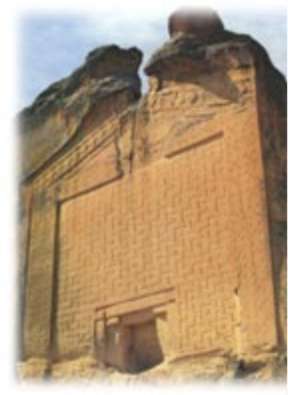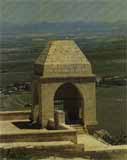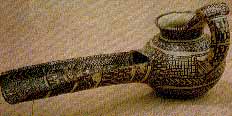

ESKiSEHiR
 City, west-central Turkey. It lies along the Porsuk River, a tributary of the
Sakarya River, at a point about 125 miles (200 km) west of Ankara. Lying near
the site of the ancient Phrygian city of Dorylaeum, the present city probably
began in Byzantine times as a cluster of settlements around hot springs. The
scene of a crusader victory over the Seljuk Turks in 1097, it came under Ottoman
control near the end of the 13th century. The city expanded with the coming of
the railway in the late 19th century and the immigration of Turks from the
European provinces of the Ottoman Empire in the early 20th century. Despite its
name (Turkish: "Old City"), most of the city was rebuilt after its
destruction in the Turkish War of Independence (1919-22).
City, west-central Turkey. It lies along the Porsuk River, a tributary of the
Sakarya River, at a point about 125 miles (200 km) west of Ankara. Lying near
the site of the ancient Phrygian city of Dorylaeum, the present city probably
began in Byzantine times as a cluster of settlements around hot springs. The
scene of a crusader victory over the Seljuk Turks in 1097, it came under Ottoman
control near the end of the 13th century. The city expanded with the coming of
the railway in the late 19th century and the immigration of Turks from the
European provinces of the Ottoman Empire in the early 20th century. Despite its
name (Turkish: "Old City"), most of the city was rebuilt after its
destruction in the Turkish War of Independence (1919-22).
Eskisehir is divided into a commercial and industrial section, situated on low ground, and a residential quarter that occupies higher ground. One of the largest industrial centers in Turkey, it produces sugar, textiles, bricks, cement, chemicals, processed meerschaum, and railway and agricultural equipment. It also has aircraft workshops and is a center for cotton research. It is a rail junction on the Istanbul-Ankara and Istanbul-Baghdad lines. Eskisehir is the seat of the University of Anatolia (1958). Pop. (1990) 413,082.
Eskisehir is one of the oldest settlements (3500 BC) in this region. It was
founded in the 3rd millennium BC by the Phrygians along the banks of the Porsuk
River and its banks. The city has many places of interest; the Archaeological
Museum which houses the Phrygian objects and sculptures; the Ottoman House
Museum which is a very fine example of the 19th century local architecture and
has many local ethnographical items. There are three significant tombs around
Eskisehir: the Sheik Edibali Tomb, the Kumbet Baba Tomb, and the Cupola of
Alemsah. The Phrygian Valley, the Falcon Fortress, the Unfinished Monument, and
the Gerdek Rock are other historical sites to visit. In Eskisehir you will
frequently see items made of meerschaum since this is the place where it
originates You will see the best meerschaum stone works at the Meerschaum
Museum. The Rug and Seyitgazi Museums have many examples of different kinds of
kilims and hand-knit and stockings.
millennium BC by the Phrygians along the banks of the Porsuk
River and its banks. The city has many places of interest; the Archaeological
Museum which houses the Phrygian objects and sculptures; the Ottoman House
Museum which is a very fine example of the 19th century local architecture and
has many local ethnographical items. There are three significant tombs around
Eskisehir: the Sheik Edibali Tomb, the Kumbet Baba Tomb, and the Cupola of
Alemsah. The Phrygian Valley, the Falcon Fortress, the Unfinished Monument, and
the Gerdek Rock are other historical sites to visit. In Eskisehir you will
frequently see items made of meerschaum since this is the place where it
originates You will see the best meerschaum stone works at the Meerschaum
Museum. The Rug and Seyitgazi Museums have many examples of different kinds of
kilims and hand-knit and stockings.
In Eskisehir it is possible to have good time at Sakaryabasi where there is a spring lake and fresh fish restaurants.
Outside Eskisehir is Sivrihisar (Justinianopolis), full of typical Ottoman houses and famous for its kilims. Seyit Battal Gazi (Nakoleia) is 45 kms south of Eskisehir. The mosque complex on the hill was built to pay homage to the Islamic hero Seyit Battal.
The Yunus Emre Village is the burial place of the world famous poet of the 13th century, Yunus Emre. There is a commemorative tomb built for him as well as a museum, and celebrations are held here every May.
"Birth Festivities" which are dedicated to Nasreddin Hodja, a humor master and folk philosopher, is organized in Eskisehir every year in the last week of June.
BALLIHISAR (PESSINUS)
 117
km from Ankara, on the Eskisehir road and 16 km to the right you will
find the Phrygian city, Pessinus, its contemporary name is Ballihisar. There you
will see the Temple of Cybele - the mother goddess, and an open-air museum
housing interesting sculptures found in this ancient Phrygian cult center, which
was built in the 10th century BC.
117
km from Ankara, on the Eskisehir road and 16 km to the right you will
find the Phrygian city, Pessinus, its contemporary name is Ballihisar. There you
will see the Temple of Cybele - the mother goddess, and an open-air museum
housing interesting sculptures found in this ancient Phrygian cult center, which
was built in the 10th century BC.
MIDAS
One of the most important settlement centers of the Phrygians, between the 8th- and 6th-centuries BC, was Midas, situated 66 km south of Eskisehir.
At this place of distant past, stands the ancient city with an acropolis overlooking the lower land. On its northwestern side are two open-air cult temples, carved into the rock, and the most interesting sight in the area. There are rock tombs and Phrygian inscriptions nearby, and a recently discovered underground tunnel which links the site to the valley extending below. The Midas Monument which was built in dedication to Cybele lies to the northwest of the ancient city.
Three tombs in the environs of Midas which were found at Kucuk Yazilikaya,
Sutunlu Kale and Doganli Kale are especially remarkable,. Kumbet and Deveboynu
are the other towns close to Midas, and visitors can enjoy the Phrygian
monuments spread over these neighboring lands.
Doganli Kale are especially remarkable,. Kumbet and Deveboynu
are the other towns close to Midas, and visitors can enjoy the Phrygian
monuments spread over these neighboring lands.
Yazılıkaya
- Midas City - The Great Monument
Situated at 90 km. from Eskişehir, the Yazılıkaya
- Midas City established during the 7th century B.C., is famous for its Great
Monument which is an important masterpiece of the Pbrygian Period. The monument
is covered with miscellaneous geometric designs and hyerogliphics. During the
Pbrygian Period religious ceremonies used to be held here
![]()
Home | Ana
Sayfa | All About Turkey | Turkiye
hakkindaki Hersey | Turkish Road Map
| Historical Places in Adiyaman | Historical
Places in Turkey | Mt.Nemrut | Slide
Shows | Related Links | Guest
Book | Disclaimer | Send a Postcard | Travelers' Stories | Donate a little to help | Getting Around Istanbul | Adiyaman Forum
|
|